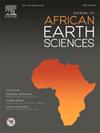东非裂谷西部裂谷带尼拉贡戈火山地下横向岩浆传播
IF 2.2
4区 地球科学
Q2 GEOSCIENCES, MULTIDISCIPLINARY
引用次数: 0
摘要
岩浆横向传播是裂谷带的共同特征,裂谷带在最小压应力下张开,垂直岩脉平行于裂谷方向流动。根据垂直和横向岩浆迁移之间的竞争,这些岩脉可能会导致喷发,也可能不会。在这种情况下,包括大厦荷载在内的地形不利于岩浆的上升,有利于从大厦中心区域向横向迁移,从而为周边的通风口提供补给。在这里,我们关注的是尼拉贡戈火山,这是一座火山大厦,位于东非裂谷的西部分支,海拔3470米。在实践中,我们研究了EAR裂谷引起的伸展和尼拉贡戈火山的地形载荷对岩脉传播面方向和岩浆在该传播面横向和垂直传播平衡的综合影响。通过考虑地形和裂谷诱导的西-东张应力场影响的解析模型和数值模型,我们发现起源于火山大厦的岩脉路径首先受到火山荷载的影响,导致径向传播。然而,在5公里以外,裂谷诱发的伸展应力场占主导地位,导致向基伍湖的南北传播。这些结果与从喷口位置推断出的岩浆路径和对尼拉贡戈火山(2002年和2021年)最后两次喷发事件的地球物理观测结果一致。另一方面,岩浆被困在湖下超过20公里的横向传播受深度依赖伸展和岩浆浮力降低的控制,并在较小程度上受向基伍湖的下坡和向南的裂谷扩展的轻微增加的控制。本文章由计算机程序翻译,如有差异,请以英文原文为准。

Subsurface lateral magma propagation from Nyiragongo volcano in the Western Rift Zone of the East African Rift
Lateral magma propagation is a common feature of rift zones, with opening against the minimum compressive stress and vertical dykes flowing parallel to the rift direction. Depending on the competition between vertical and lateral magma migration, these dykes may either feed an eruption or not. In this context, the topography which includes the edifice load acts against the rise of the magma and favours lateral migration radially away from the edifice central area, thus feeding peripheral vents. Here, we focus on the Nyiragongo volcano, a volcanic edifice located in the western branch of the East African Rift and culminating at 3,470 meters above sea level. In practice, we study the combined effect of the extension induced by the rifting of the EAR and the topographic loading of the Nyiragongo volcano on the orientation of the dyke propagation plane and on the balance between the lateral and vertical propagation of the magma in this propagation plane. Using analytical and numerical models taking into account the effect of topography and the rift-induced west-east extensional stress field, we show that the path of a dyke originating from the volcanic edifice is first influenced by the load of the volcano, leading to a radial propagation. Beyond 5 km, however, the rift-induced extensional stress field dominates leading to a north–south propagation towards Lake Kivu. These results are consistent with the path of the magma deduced from the position of the vents and geophysical observations for the last two eruptive events of the Nyiragongo volcano (2002 and 2021). On the other hand, the lateral propagation over more than 20 km, where the magma remains trapped beneath the lake, is shown to be controlled by depth-dependent extension and reduced magma buoyancy and, to a lesser extent, the downslope towards Lake Kivu and the slight increase in rift extension towards the south.
求助全文
通过发布文献求助,成功后即可免费获取论文全文。
去求助
来源期刊

Journal of African Earth Sciences
地学-地球科学综合
CiteScore
4.70
自引率
4.30%
发文量
240
审稿时长
12 months
期刊介绍:
The Journal of African Earth Sciences sees itself as the prime geological journal for all aspects of the Earth Sciences about the African plate. Papers dealing with peripheral areas are welcome if they demonstrate a tight link with Africa.
The Journal publishes high quality, peer-reviewed scientific papers. It is devoted primarily to research papers but short communications relating to new developments of broad interest, reviews and book reviews will also be considered. Papers must have international appeal and should present work of more regional than local significance and dealing with well identified and justified scientific questions. Specialised technical papers, analytical or exploration reports must be avoided. Papers on applied geology should preferably be linked to such core disciplines and must be addressed to a more general geoscientific audience.
 求助内容:
求助内容: 应助结果提醒方式:
应助结果提醒方式:


